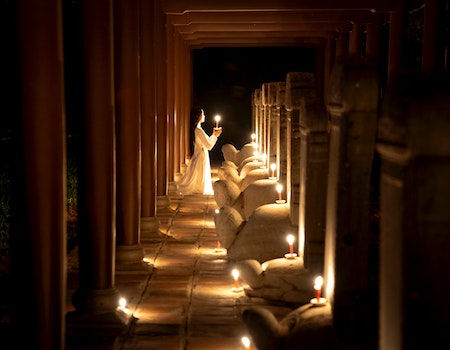The Temple of Mystery
Stories similar to this that you might like too.
“There you are, my dear,” Dr. Sato said. “I was just telling your father that we have finally found out why he has been so depressed lately.”
A tall, handsome man in a long black robe walked over to them from the other side of the room and placed his arm around her shoulders. The woman smiled up at him happily.
“I think we can help your husband now with this new treatment program for depression,” she continued. “You see, it isn’t that he is suffering from clinical depression as such, but rather from a condition that we call ‘temporary situational depression.’
It’s quite common among people who live stressful lives or who have had a major traumatic experience. It tends to be a temporary condition which usually clears up itself after several months when all the stressors have gone away.”
She paused for a moment and then said, “I’m sure you understand how difficult it must be to go through what he’s been going through lately. I know that there will still be a lot of work ahead, but you should see an improvement in him within two months.”
The man nodded and looked down at the woman who gave him another smile. Then he leaned forward and whispered something into her ear. She nodded and then took her husband by the hand and led him back into the crowd that surrounded them.
Dr. Sato reached down and picked up the remote control sitting on the table beside his chair. He switched off the television set and turned towards the doorway leading out to the patio where he had left his wife. The door creaked slightly as he pulled it open and stepped outside.
A few seconds later his wife joined him, followed closely behind by one of their maids. The three of them sat down on the outdoor lounge chairs surrounding the small fire pit that they kept burning in the evenings to take advantage of the cool summer air. They watched the fire for several minutes before Dr. Sato spoke up and asked, “So, how did it go?”
“He was very happy to hear about the success rate of our treatments and the fact that he should see a big improvement in only two months. He told me to tell you that he would contact you as soon as possible after he gets back from New York and that he’ll try to get in touch with you while he’s in town to make sure things continue to progress well.
We’ll need to schedule his next follow-up appointment shortly. In addition to that, you might also want to give his secretary a call to let her know that he won’t be able to do any more of her personal shopping until further notice.”
The doctor nodded and sighed heavily. “That’s good news, dear, but if we don’t get some relief soon it looks like we’re going to lose everything!”
“Honey, don’t worry,” Mrs. Sato said gently. “Things will turn around. You just keep doing whatever needs to be done, and I will take care of the rest. I’ve got a couple of tricks up my sleeve that we haven’t tried yet…”
***
The temple of mystery has many secrets; none more important than that of its origins. There are those who believe the building itself is older than recorded history—that its original structure may have predated the rise of the Sumerians.
Yet, no matter how ancient the origin, all agree that what exists today is a temple built by ancient Egyptian monks who fled to the desert for religious freedom during the dark days of their society. The monks built the temple atop an oasis and used it to study their faith in peace, away from prying eyes and intrusive questions.
But, as often happens in history, the monastery was discovered and plundered by the Romans who wanted the valuable stone for buildings within their empire.
It’s said that the monks were able to hide the majority of their sacred writings by covering them with plaster and paint, thereby disguising them as ordinary objects, but one volume of the books they hid had a unique property: It glowed in the presence of certain frequencies of light.
This book was hidden in a secret chamber deep inside the temple and was passed from one monk to another for centuries. At some point in the past, someone removed it from its hiding place, and it eventually ended up in a private collection owned by a wealthy collector of antiquities known only as Mr. B.
One day, a young graduate student studying under Professor D. E. F. Lacey stumbled across this particular book and was fascinated by its unusual properties. As soon as he realized that it could detect specific frequencies of electromagnetic energy, he decided to build his own set of antennae and test the limits of their sensitivity.
The result of his efforts was the discovery of a previously unknown type of electromagnetic signal emanating from the walls of the temple and proving that they were constructed from an alloy with an unusually high level of rare earth elements.
As the story goes, the young graduate student began experimenting with the material and found that it emitted a specific range of frequencies when exposed to light.
Using the information he gathered from his experiments, he began constructing his own set of devices which enabled him to detect a wide variety of other signals and even generate them artificially in some instances. It wasn’t long before word spread throughout the scientific community about his amazing accomplishments.
Word also reached the ears of Mr. B. who was quite impressed with the young man’s accomplishments. He offered to buy the young man out so that he could work full-time on developing new methods to exploit the potential of the materials he had discovered.
The young man happily accepted and soon moved his family to the small coastal village near San Diego where Mr. B.’s research facilities were located.
A few years later, Professor D. E. F. Lacey died and left half of his estate to the young graduate student for the sole purpose of supporting his research on behalf of the United States government. His wife received the remainder of their fortune to ensure that she wouldn’t remarry or be tempted to spend the money unwisely.
After receiving their inheritances, the young graduate student took his family to live at the laboratory complex on the southern tip of the island nation of Hawaii.
The young man continued refining and testing the technology he’d developed and eventually made contact with members of the military who had an interest in his work. Soon, a number of prototypes were manufactured and tested in combat situations all over the world, with varying degrees of success.
These early models were crude, bulky, and required extensive maintenance. In order to avoid detection, they needed to be hidden behind a camouflaging field that generated a narrow band of electromagnetic wavelengths at random intervals.
In short order, a few minor improvements were added to these systems, allowing them to use the same camouflage pattern for a much wider range of frequencies. The military liked the idea but was still wary of using them as they feared that they would draw attention and possibly attract enemy fire.
It wasn’t until a few months ago that a prototype was deployed into combat conditions for the first time during Operation Iron Fist. A small force of U.S. Marines carried the device, which was disguised as a standard-issue rifle, into the city of Khatash and successfully eliminated a large enemy presence without drawing any significant opposition fire.
This success led to several more deployments of the weapons during subsequent engagements with terrorist forces operating on the island nation of New Hong Kong.
As the military slowly became more comfortable with these new technologies, they were incorporated into regular Army issue rifles and issued to soldiers serving in numerous locations worldwide. They proved extremely useful against terrorists, guerrillas, and various insurgent groups around the globe, including in the Middle East, Africa, and Asia, as well as in Europe and South America.
However, after the attacks on the World Trade Center and Pentagon and subsequent invasions of Afghanistan and Iraq, the US government ordered that all of these weapons be stored in secure facilities until they could be properly examined to determine whether they should be used in future operations overseas.
The End


